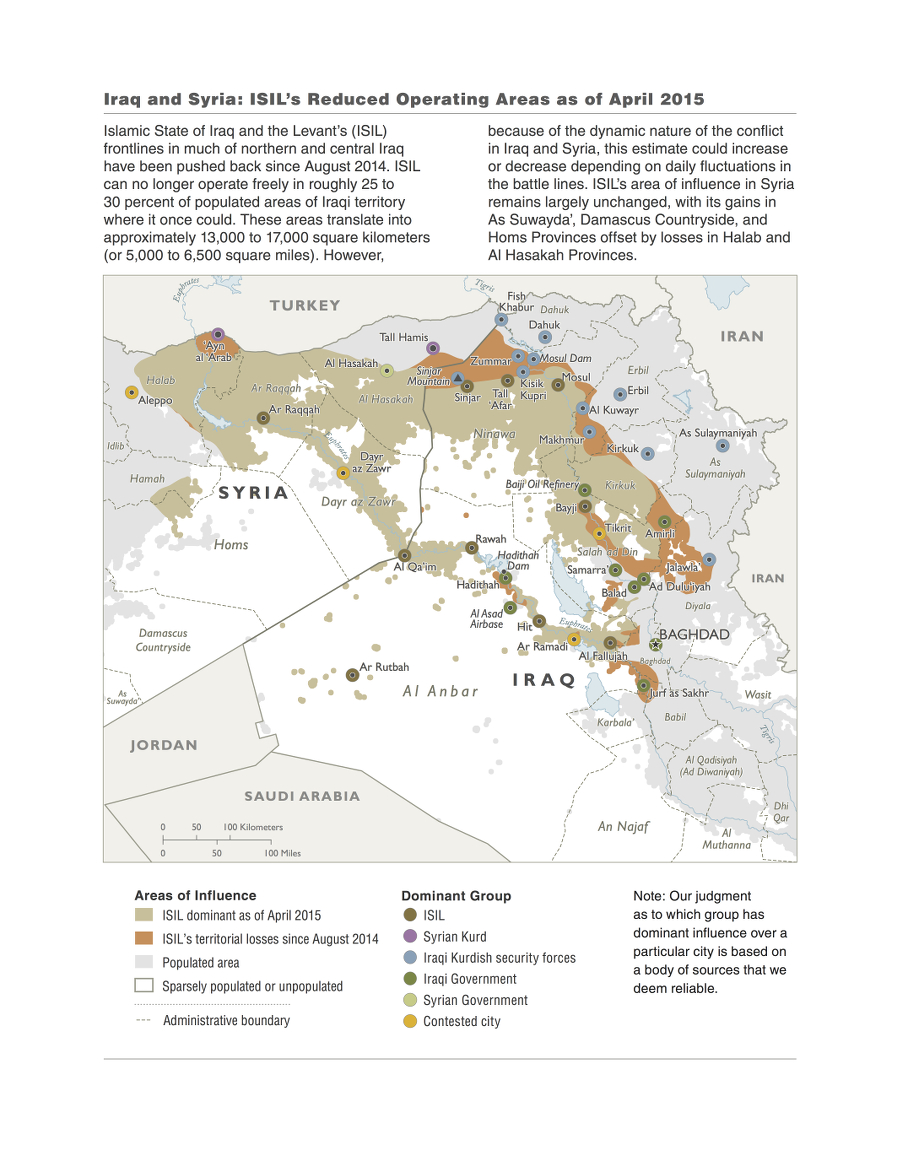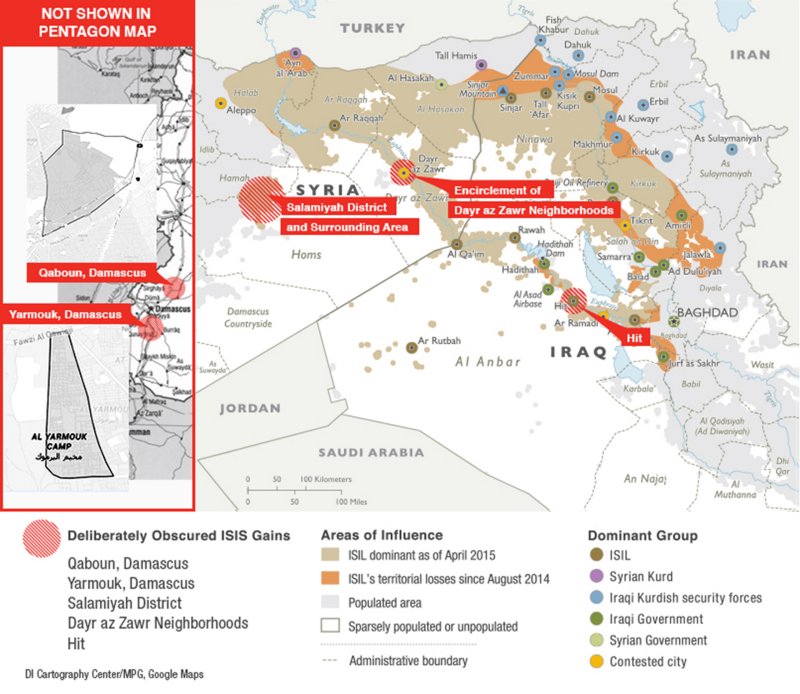http://www.independent.co.uk/voices/comment/isis-on-the-run-the-us-portrayal-is-very-far-from-the-truth-10221225.html 3 May 2015 Isis on the run? The US portrayal is very far from the truth The map issued by the Pentagon to prove that Isis had lost territory shows how false optimism dominates the actions of the outside powers towards the Middle East Patrick Cockburn A graphic illustration of Western wishful thinking about the decline of Islamic State (IS) is a well-publicised map issued by the Pentagon to prove that the self-declared caliphate has lost 25 per cent of its territory since its big advances last year. Unfortunately for the Pentagon, sharp-eyed American journalists soon noticed something strange about its map identifying areas of IS strength. While it shows towns and villages where IS fighters have lost control around Baghdad, it simply omits western Syria where they have been advancing in and around Damascus. The Pentagon displayed some embarrassment about its dodgy map, but it largely succeeded in its purpose of convincing people that IS is in retreat. Many news outlets across the world republished the map as evidence of the success of air strikes by the United States and its allies in support of the Iraqi army and Kurdish forces in Iraq and Syria. The capture of Tikrit [1] after a month-long siege is cited as a further sign that a re-energised Iraqi state is winning and one day in the not too distant future will be able to recapture Mosul in the north and Anbar province in the west. How much of this comforting news is true? Recall that the loss or retention of territory is not a good measure of a force such as IS using quasi-guerrilla tactics. Good news from the point of view of Baghdad is that its forces finally retook the small city of Tikrit, though its recapture was primarily the work of 20,000 Shia militia and not the Iraqi army, which only had some 3,000 soldiers involved in the battle. It was not a fight to the finish and General Martin Dempsey, chairman of the US Joint Chiefs of Staff, said IS only committed a few hundred fighters to holding the city. Success at Tikrit was trumpeted at home and abroad and was to be followed by an Iraqi army offensive in Anbar province and possibly an assault on Mosul later in the year. But, just as this was supposed to begin, IS fighters attacked Baiji oil refinery, the largest in Iraq, and Ramadi, the capital of Anbar province, showing that they retain their offensive capability. As of last Thursday, IS fighters had seized most of the 36-square-kilometre refinery compound with only a few pockets of Iraqi federal police and soldiers still holding out. "We have very little food and ammunition, and we can't withstand the suicide bombers, snipers and rockets," said a federal police officer reached by phone by the Iraq Oil Report. "All of us are thinking of committing suicide." What emerges from the latest round of fighting is not only that IS retains the ability to launch offensives over a wide area, but that the Iraqi army very much depends on rushing a small number of elite combat units like so many fire brigades to cope with successive crises. One source in Baghdad told me that the number of troops useable for these purposes was about five brigades or some 15,000 soldiers. Other published reports suggest the number may be even smaller at 5,000 men drawn from the so-called Golden Brigade, an Interior Ministry Swat team and a unit known as the Scorpions. When these small but effective forces succeed in repelling an IS attack there is nobody in the regular army to hold the positions they have defended. A key question since IS captured much of northern and western Iraq last year concerns the ability of the Iraqi army to reconstitute itself after such a defeat. Going by recent fighting this is simply not happening, and failure here has important political consequences for Iraq and the region as a whole. It means that IS is not being beaten back by the regular army in its most important strongholds in Iraq. As a result the Baghdad government is this weekend poised to send Shia militias into overwhelmingly Sunni Anbar province to reinforce the army. "We are under tremendous pressure," an army officer fighting in Anbar was quoted as saying. "We are in the midst of a war of attrition, which I am afraid will play into the hands of Islamic State." He described their fighters as being "everywhere". The move of Shia militiamen, organised and in part directed by Iranian officers, into western Sunni Iraq creates a dilemma for the US. The Americans have been insisting that the militias be under the military control of Baghdad, though how you prove this is another matter. Washington had been hoping to repeat, if only in miniature, its success in using anti-al-Qaeda tribes and communities against the jihadis in 2006-08. Today this is almost impossible because there are no longer 150,000 US troops in Iraq, IS has shown it will kill anybody opposing it, and Sunni-Shia sectarian fear and hatred is deeper than ever. The 90,000 Sunni refugees who fled Ramadi for Baghdad when the fighting started found it difficult or impossible to enter the capital because they were suspected of being IS infiltrators. Their fate is a grim illustration of the degree to which Iraq no longer exists as a unified country. At the heart of the failure of the US and its allies to defeat IS over the last 10 months is the problem that what makes military sense is politically toxic and vice versa. The strongest military force opposing IS in Iraq is the Iranian-backed Shia militias, but the US imperative to limit Iranian influence in Iraq means that it does not want to support the militias with air strikes. In Syria, there is a somewhat similar situation since the Syrian army is the most powerful military force in the country, but it does not receive US tactical air support when fighting IS or Jabhat al-Nusra, the al-Qaeda affiliate, because a US priority remains to displace President Bashar al-Assad. As a result IS is not under serious military pressure in Syria and its leader, Abu Bakr al-Baghdadi, has recently issued orders for fighters to transfer from Aleppo to Iraq. Wishful thinking about the strength of IS and other al-Qaeda-type movements is not confined to foreign powers. Baghdad governments are always inclined to believe their own propaganda or see themselves as victims of conspiracies. Last summer the Shia leaders in Baghdad had convinced themselves that they were the victims of a conspiracy in which the Kurds were in league with IS. It came as a shock to them when the Kurds were the next victims of an IS offensive last August. In Baghdad last week the Interior Minister, Mohammed Salem al-Ghabban, summoned dozens of journalists to meet him so he could blame them for creating the conditions for IS successes. The Pentagon's misleading map shows the degree to which false optimism dominates the thoughts and actions of the outside powers in Iraq, Syria and rest of the Middle East. It reminds me of the situation early last year when President Obama, in receipt of the best information US intelligence could give him, dismissed IS as being the equivalent of a small-time basketball team whose actions were of no importance.

 [1] http://www.independent.co.uk/news/world/middle-east/war-with-isis-iraq-declares-victory-in-the-battle-for-tikrit--but-militants-make-make-ominous-advances-in-neighbouring-syrias-capital-10150360.html
[1] http://www.independent.co.uk/news/world/middle-east/war-with-isis-iraq-declares-victory-in-the-battle-for-tikrit--but-militants-make-make-ominous-advances-in-neighbouring-syrias-capital-10150360.html